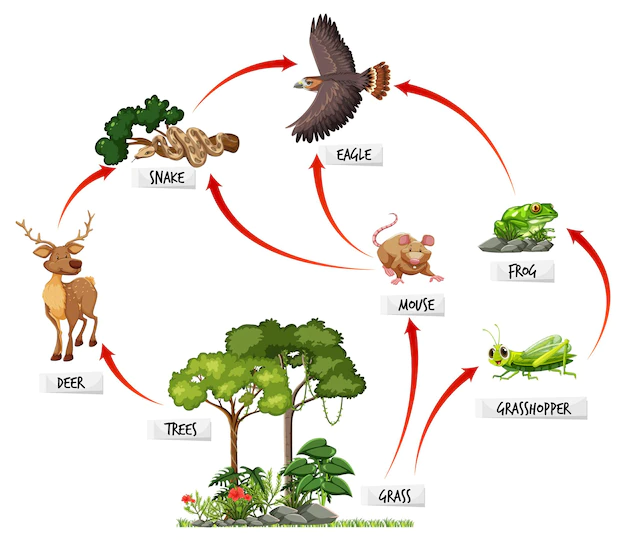A type of organism that makes its own food (usually from sunlight).
Producer
A species that lives in the ecosystem that it originated and evolved in is known as this
Native Species
In this food web, this is an example of a producer
Grass or Trees
True or false. The number of grey wolves in WI has increased since the 1980s.
True.
The 1st (broadest) taxonomy level
Kingdom
The science of classifying organisms.
Taxonomy
A species that does not live in the ecosystem it originated in is known as this.
Non-native species (sometimes an invasive species)
In this food web, this is an example of a primary consumer

Deer, Mouse, or Grasshopper
This is a concern that some farmers have about the increasing grey wolf population.
Livestock/pet safety.
The 7th (most specific) taxonomy level
Species
A type of species that lives in an ecosystem that it did not originate and evolve in.
Non-Native Species
True or false, there are more species of insects than all of the other animal species combined?
True. About 80% of all animal species are insects.
In this food web, this is an example of a secondary consumer

Frog, Snake, or Eagle
Grey wolves mostly live in this region of WI
North (and central)
The 2nd taxonomy level
Phylum
A type of organism that eats a primary consumer.
Secondary Consumer
The most common type of organism found on the SHMS grounds this year were arthropods. Arthropods include these kinds of organisms.
Insects, arachnids, and crustaceans.
In this food web, this is an example of a Tertiary consumer

Eagle
This is a reason that a grey wolf might target a sick deer over a healthy one. (Think about the predator prey game we played)
It costs the wolf less energy to capture a sick deer.
The 6th taxonomy level
Genus
A type of organism that has no natural predators in its ecosystem.
Apex Predator
There are 100 oak trees inside an area of 10 km2. The population density would be this many oak trees/km2
10 oak trees/km2
If all mice suddenly died out, this is something that might happen to this ecosystem.

Snake/Eagle population might decline.
Grass population might increase.
Deer and frog population might decline from extra predation.
The scientific name for the Gray Wolf species is this
Canis Lupus
Which of these organisms are more closely related?
Organism | Kingdom | Phylum | Class | Order | Family | Genus | Species
-----------------------------------------------------------------------------------------------
Lion | Animalia | Chordata | Mammalia | Carnivora | Felidae | Panthera | leo
Hyena | Animalia | Chordata | Mammalia | Carnivora | Hyaenidae | Crocuta | crocuta
Brown Mouse | Animalia | Chordata | Mammalia | Rodentia | Muridae | Mus | musculus
Lion and Hyena